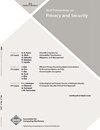RansomShield: A Visualization Approach to Defending Mobile Systems Against Ransomware
IF 3
4区 计算机科学
Q2 COMPUTER SCIENCE, INFORMATION SYSTEMS
引用次数: 3
Abstract
The unprecedented growth in mobile systems has transformed the way we approach everyday computing. Unfortunately, the emergence of a sophisticated type of malware known as ransomware poses a great threat to consumers of this technology. Traditional research on mobile malware detection has focused on approaches that rely on analyzing bytecode for uncovering malicious apps. However, cybercriminals can bypass such methods by embedding malware directly in native machine code, making traditional methods inadequate. Another challenge that detection solutions face is scalability. The sheer number of malware variants released every year makes it difficult for solutions to efficiently scale their coverage. To address these concerns, this work presents RansomShield, an energy-efficient solution that leverages CNNs to detect ransomware. We evaluate CNN architectures that have been known to perform well on computer vision tasks and examine their suitability for ransomware detection. We show that systematically converting native instructions from Android apps into images using space-filling curve visualization techniques enable CNNs to reliably detect ransomware with high accuracy. We characterize the robustness of this approach across ARM and x86 architectures and demonstrate the effectiveness of this solution across heterogeneous platforms including smartphones and chromebooks. We evaluate the suitability of different models for mobile systems by comparing their energy demands using different platforms. In addition, we present a CNN introspection framework that determines the important features that are needed for ransomware detection. Finally, we evaluate the robustness of this solution against adversarial machine learning (AML) attacks using state-of-the-art Android malware dataset.勒索盾:一种保护移动系统免受勒索软件攻击的可视化方法
移动系统的空前增长已经改变了我们处理日常计算的方式。不幸的是,一种被称为勒索软件的复杂恶意软件的出现对这种技术的消费者构成了巨大的威胁。传统的移动恶意软件检测研究主要集中在依赖于分析字节码来发现恶意应用程序的方法上。然而,网络犯罪分子可以通过将恶意软件直接嵌入本机机器码来绕过这些方法,这使得传统方法无法发挥作用。检测解决方案面临的另一个挑战是可伸缩性。每年发布的恶意软件变种的绝对数量使得解决方案很难有效地扩展其覆盖范围。为了解决这些问题,这项工作提出了RansomShield,一种利用cnn检测勒索软件的节能解决方案。我们评估了已知在计算机视觉任务上表现良好的CNN架构,并检查了它们对勒索软件检测的适用性。我们表明,使用空间填充曲线可视化技术系统地将Android应用程序的本地指令转换为图像,使cnn能够以高精度可靠地检测勒索软件。我们描述了这种方法在ARM和x86架构上的健壮性,并证明了这种解决方案在包括智能手机和chromebook在内的异构平台上的有效性。我们通过比较使用不同平台的移动系统的能量需求来评估不同模型的适用性。此外,我们提出了一个CNN自省框架,该框架确定了勒索软件检测所需的重要特征。最后,我们使用最先进的Android恶意软件数据集评估了该解决方案对对抗性机器学习(AML)攻击的鲁棒性。
本文章由计算机程序翻译,如有差异,请以英文原文为准。
求助全文
约1分钟内获得全文
求助全文
来源期刊

ACM Transactions on Privacy and Security
Computer Science-General Computer Science
CiteScore
5.20
自引率
0.00%
发文量
52
期刊介绍:
ACM Transactions on Privacy and Security (TOPS) (formerly known as TISSEC) publishes high-quality research results in the fields of information and system security and privacy. Studies addressing all aspects of these fields are welcomed, ranging from technologies, to systems and applications, to the crafting of policies.
 求助内容:
求助内容: 应助结果提醒方式:
应助结果提醒方式:


